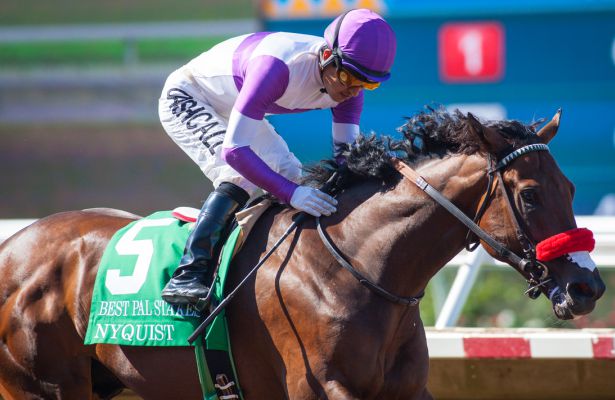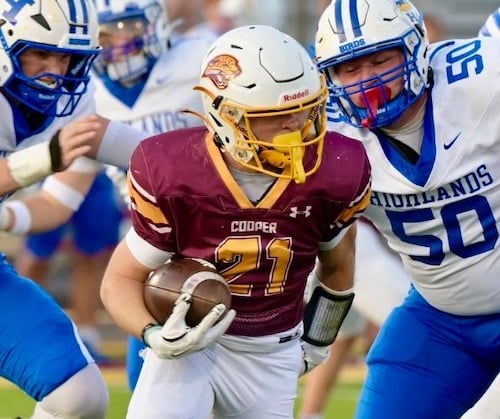“Winning takes precedence over all. There is no gray area. No almosts.”
— Kobe Bryant
I am one of those suckers who have such an affinity for gray thoroughbreds that whenever I see one in a race, I’ll bet on him and discard all other handicapping information.
One reason, I guess, is that there are so few grays out there. Of the 21,275 thoroughbreds foaled in 2013, only about eight percent were gray, according to Jockey Club statistics.
So that makes it downright remarkable that five grays are on track in the 142nd Kentucky Derby on Saturday, May 7. The most formidable is Nyquist, who ran his record to 7-for-7 with an impressive victory in the Florida Derby. But the other four grays – Creator, Destin, Lani, and Mohaymen – are no slouches. All will be among the top betting choices in the 20-horse field.

Even more amazingly, three of the four grays – Lani, Mohaymen, and Creator – all are by the same foal, Tapit, who ran ninth to Smarty Jones in the 2004 Derby. A great-grandson of 1977 Triple Crown winner Seattle Slew, Tapit has been North America’s leading sire the last couple of years.
Most thoroughbreds are registered as bay, brown, dark bay or brown (almost black), or gray. For years, the Jockey Club recognized a color known as “roan,” which meant the horse had a coat of either red or gray hair mixed with white. But since that color was so close to gray, the Jockey Club finally lumped them together.
Beginning with Determine in 1954 – hard to believe the Derby had been run 79 times before a gray won it – grays have won the roses eight times. Officially, that is. I always will put an asterisk next to Forward Pass in 1968 because he was moved up from second when the victorious gray, Dancer’s Image, was disqualified because a then-illegal medication was detected in his post-race urinalysis.
At subsequent hearings and court appearances, it became clear that the testing laboratory had botched its work so completely that the test should have been thrown out. Instead, the Kentucky State Racing Commission came down in favor of the “home” team – Lexington’s iconic Calumet Farm – instead of Boston millionaire Peter Fuller, who owned Dancer’s Image.
To his dying day, Fuller believed he was the victim of a scam cooked up by Dr. Alex Harthill, the notorious Louisville veterinarian known throughout the industry as the “Derby Doc.” But Harthill denied all the charges and to this day the case of Dancer’s Image is racing’s all-time unsolved mystery.
Probably the best gray to run in the Derby was one that didn’t win it. That would be the brilliant Native Dancer, who suffered his only loss in 22 career starts when Dark Star held him off by a head in 1953. The winner was bred by Warner L. Jones Jr., who served for years on Churchill Down’s board of directors.
Jockey Eric Guerin, who rode Jet Pilot to victory in the 1947 Derby, had no excuses for Native Dancer’s loss to Dark Star, other than getting bumped by another horse early in the race. But he had plenty of time to recover and more than enough class to overcome such a minor incident.
Had he won as expected, Native Dancer would have been the first gray to win the roses. Instead, that barrier was smashed the next year by Determine, who overcame a rough start to win for jockey Ray York and owner A.J. Crevolin.
Since Determined, the Derby has been won – officially – by seven horses listed as either gray or roan. They are Decidedly (a son of Determine) in 1962, Spectacular Bid in 1979, Gato Del Sol in 1982, Winning Colors in 1988, Silver Charm in 1997, Monarchos in 2001, and Giacomo in 2005.
Spectacular Bid is the best gray to win the Derby. Trained by the loquacious Grover “Bud” Delp and ridden by the callow Ronnie Franklin, he rolled through the Derby and Preakness with so much authority that he seemed a cinch to become the fourth Triple Crown winner of the 1970s. But he stepped on a safety pin before the Belmont Stakes – that’s the story, at least – and the subsequent infection caused him to run only third in the Belmont Stakes.
In 1988, trainer D. Wayne Lukas won his first Derby with the huge filly Winning Colors, who joined Regret in 1915 and Genuine Risk in 1980 as the only females to win the Derby. Ridden by Gary Stevens, she barely held off a desperate late charge by Claiborne Farm’s Forty Niner.
Perhaps the second best gray to get win the Derby, trailing only Native Dancer, was Monarchos in 2001. His winning time of 1:59.97 for the mile and a quarter is second only to Secretariat’s record of 1:59 2/5. However, it’s only the third fastest time in Derby history because Sham ran faster in finishing second to Secretariat than Monarchos did in winning.
When the gray Giacamo won the 2005 Derby at 50-to-1, he earned a measure of redemption for his sire, Holy Bull, a gray who went off as the 2-to-1 favorite in 1994, but could do no better than 12th to Go for Gin on a sloppy track that was not to his liking.
Another outstanding gray who threw in a Derby clunker was Skip Away, who finished 12th to Grindstone in 1996. Owned by Carolyn Hine and trained by her husband Sonny, Skip Away went on to win Horse of the Year honors as a 5-year-old in 1998.
If five grays make it into the starting game in Derby 142, it will tie and the 1968 and 1981 fields for most grays in one Derby. Yet as a group, the grays of 2016 seem to be more talented than either the fields of ’68 and ’81.
Begin with Nyquist. What’s not to like? He has won in California, Florida, and Kentucky. He has won on the lead and from back in the back. The only reason to not go ahead and send him the roses is the bad luck looming in the Derby’s 20-horse field.
For a few weeks, Mohaymen sat atop the Derby rankings due to his unbeaten record and two impressive victories in Florida. But then he took on the invading Nyquist in the Florida Derby and failed to fire in the stretch, finishing fourth and leading to a mass exodus from his bandwagon.
Creator earned some fans with his last-to-first victory in the Arkansas Derby, the prep American Pharoah used last year to vault into the Derby favorite’s role, and Destin still has plenty of supporters despite his fourth-place finish in the Louisiana Derby. Earlier in the year, he won the Tampa Bay Derby impressively.
That leaves the mystery horse, Lani, who has as much gray in his past performance as in his coat. Although bred in Kentucky, he has raced exclusively in Japan and Dubai. He earned his (long) trip to Churchill Downs with a 1 ¾-length victory in the $2 million UAE Derby on March 16 in Dubai.
You can bet I’ll have money on more than one gray in Derby 142. Heck, a fellow could play all five in a $1 exacta box for $20. What a headache. Or, as the actress Jodie Foster once said, “Part of me longs to do a job where there’s not a gray area.”
Billy Reed is a member of the U.S. Basketball Writers Hall of Fame, the Kentucky Journalism Hall of Fame, the Kentucky Athletic Hall of Fame and the Transylvania University Hall of Fame. He has been named Kentucky Sports Writer of the Year eight times and has won the Eclipse Award twice. Reed has written about a multitude of sports events for over four decades, but he is perhaps one of media’s most knowledgeable writers on the Kentucky Derby






















